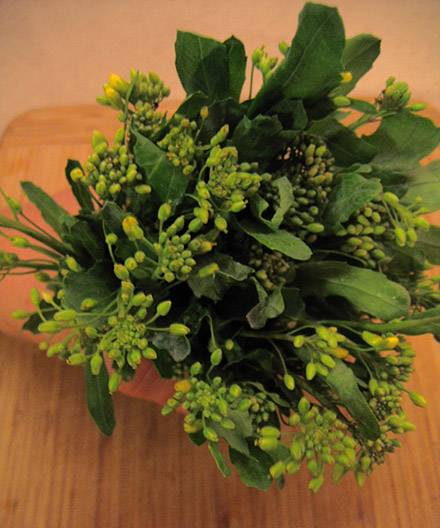 It’s been said that growing things in East Central Illinois is as easy as throwing seeds out your back door. Yes, that’s exaggerating a bit, frankly a lot in a year like this. But, I never cease to be amazed at the melons, cherry tomatoes, and potatoes that spring from compost piles in my neighborhood.
It’s been said that growing things in East Central Illinois is as easy as throwing seeds out your back door. Yes, that’s exaggerating a bit, frankly a lot in a year like this. But, I never cease to be amazed at the melons, cherry tomatoes, and potatoes that spring from compost piles in my neighborhood.
In addition to being blessed with fertile soils, we also are blessed with farmers willing to take chances on vegetables that are more common in Europe than on this side of the Atlantic. Over the years, they’ve brought us fennel, Romanesco, and broccoli raab.
If you haven’t had broccoli raab, gai lan as it is known in China, or rapini as it is known in Italy, you have some catching up to do. Now you’ll have to add napini to your list, as well.
In fact, you may want to put it ahead of rapini. Rapini is a member of the turnip family that looks like tiny, leafy broccoli often with yellow flowers. Its taste is nutty and a bit bitter, which is why it is not as popular as broccoli with most Americans.
However, napini hales from the milder kale family. A frost-hardy crop, napini kale or raab is planted in the fall and overwintered to produce thick, sweet, tender flower shoots. While many varieties of kale will produce napini, some are specifically bred for it. Once the day length exceeds 12 hours, napini takes off. So, the season can start as early as March and last well into spring or early summer as many varieties also tolerate heat.
Napini ranges in color from light green to purple, though the purple will turn dark green when cooked. Like leaf kale, it is high in calcium, and off the charts in vitamins A, C, and K, literally 1000 percent of your recommended daily allowance of the latter.
But where most people simply sauté rapini in butter or olive oil with a little thinly sliced garlic, napini is more versatile. Its milder taste allows it to be used not only in rapini recipes but also in recipes that call for broccoli and asparagus.
So chop some up and add it to omelets and frittatas. Or, put a handful in rice pilaf or risotto during the last minutes of cooking. Garlic, shallots, and lemon all work well with napini.
You can find napini at Blue Moon’s stand at the Saturday farmers market at Lincoln Square, as well as at Common Ground Food Coop. For an easy weeknight meal combine napini with pasta, white beans, lemon, and a little cheese…
Napini, White Beans, and Pasta
Serves 4
- 8 ounces cooked, dried pasta like orecchiette, farfalle, or medium shells (reserve 1 cup pasta water)
- 1, 15-ounce can cannellini beans, rinsed and drained
- 2 t lemon zest
- 1 T lemon juice
- 1 clove garlic, thinly sliced
- 2 T olive oil
- 1 bunch napini, washed and chopped into 2-inch pieces
- Pinch of red pepper flakes
- Salt and pepper
- Additional olive oil
- Freshly grated Parmesan, grana padano, asiago, Romano, or other dry cheese like cotija
Cook pasta in boiling water according to package directions. Drain, reserving 1 cup of pasta water. Meanwhile, drain and rinse beans. Zest and juice lemon. In a large skillet, sauté garlic in 2 T olive oil. When garlic is fragrant, add napini. As napini begins to wilt, add lemon zest and beans. Add a pinch of red pepper flakes and lemon juice. Add pasta water as necessary to moisten. When beans are warmed through, taste and add salt, pepper. Drizzle with additional olive oil if desired . Place in serving bowl. Serve with grated cheese.








